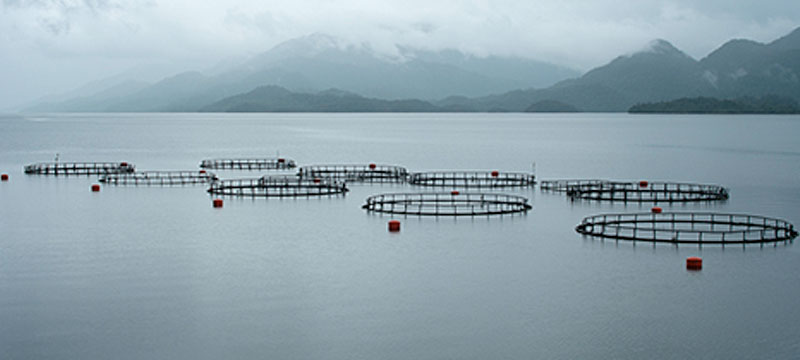The Protein Paradox: Mired in Conflict, Aquaculture is Poised for Progress
If we continue to over-harvest, over-consume, and over-pollute coastal waters and the deep ocean, aquaculture will be the only way forward to feed and sustain a growing world population. The fish world is changing…

It’s been a while since we have discussed aquaculture here on this forum. We surely remember the controversy first associated with the industry: conflict with local fishermen, pollution by fish waste and feed, the use of antibiotics to control pests and disease, escape into and compromise of wild fish, and much more. In many areas, where I live and in other north Atlantic waters, enthusiasm for aquaculture has waned or has been redirected to shellfish: mussels and oysters in particular.
Nonetheless, farm-grown fish is ever more prevalent as market share and as distinguished from fish wild caught, this latter communications phenomenon is much a result of increased public awareness of the scarcity of fish in general as a result of over-fishing, the near eradication of some species from our diet, and from the ocean entirely. The key differential is, of course, price. And in some cases quality and taste.
But the crisis in fisheries remains. Consumption rates grow, patterns of illegal and over-fishing continue, and the need for aquaculture as a strategy for supply expands to meet the increasing consumer demand. The aquaculture industry has a de facto roll as a function of necessary protein to sustain and nurture human health; the question posed was, “Could we cleanup its process and product as a responsible response to global nutritional requirement?”
If you take salmon as an example, you can present a case for astonishing industry progress. Norway has been responsible for much of this, and at the recent Economist World Ocean Summit of ocean leaders, the CEO of Cermaq, a major Norwegian salmon farm, outlined the steps taken to change the industry from a negative to a positive producer in the world market.

First: vaccines have been introduced to substitute for antibiotics, each fish inoculated against disease just as humans; second: DNA genetics have been programmed to be resistant to specific biological threats; third: the composition of feed has been replaced by sustainable materials from vegetables and bio-industry byproducts; and fourth: the structure of farms has been radically modified, strengthened, and secured, and the in-the-water pens redesigned.
What is most astonishing is the capacity to track fish through remarkable new technology: every fish identified as an individual, and data collected accrued to the specificity of one animal within a group. Thus, the capacity exists to sort fish according to individual characteristics and needs: size, feed, treatments, pest control, and other measures of growth and health. It also enables immediate notice and control of the potential escape of any single fish, reducing introduction of farm-fish into the wild to a minimum. The consequence of these process modifications is the production of salmon that maximizes its value within the entirety of human need and concern.

But the salmon industry has further surprise, again at the initiative of Norway. Last month, here in Maine in the United States where I live, two different Norwegian companies announced a total of $750 million to be invested in two coastal towns where newly constructed aquaculture plants employing several hundred workers will be built as closed system farms on-shore. This is another revolutionary change, relocating the farm process to land, adjacent to a salt water supply for intake, serving a closed circuit system for growth, treating the waste as part of the process, recycling the water, and returning only treated output back to the ocean, pollution free. In both cases, these enterprises have been located on public property, re-employing workers and replenishing the economic and cultural vitality of two towns in real need of revitalization.
This progress is certainly not confined to Norway or the United States. On a recent trip to Chile where traditional salmon farming is a large part of the national economy, similar change is forthcoming, and not limited to salmon only. In Valparaiso I met an entrepreneur with a site and financing for a similar onshore, closed circuit farm to grow Chilean sea bass through its entire life cycle using similar technology.
The fish world is changing.
If we continue to over-harvest, over-consume, and pollute coastal waters and the deep ocean, aquaculture will be the only way forward to feed and sustain the public health of a growing world population. Protein and fresh water are the two essential requirements for individual and community survival. Through aquaculture and desalination, the ocean will provide both in full, if we will only let it be.
- - -
PETER NEILL is founder and director of the W2O and is author of The Once and Future Ocean: Notes Toward a New Hydraulic Society. He is also the host of World Ocean Radio, a weekly podcast addressing ocean issues, upon which this blog is inspired.
- Login to post comments
-


